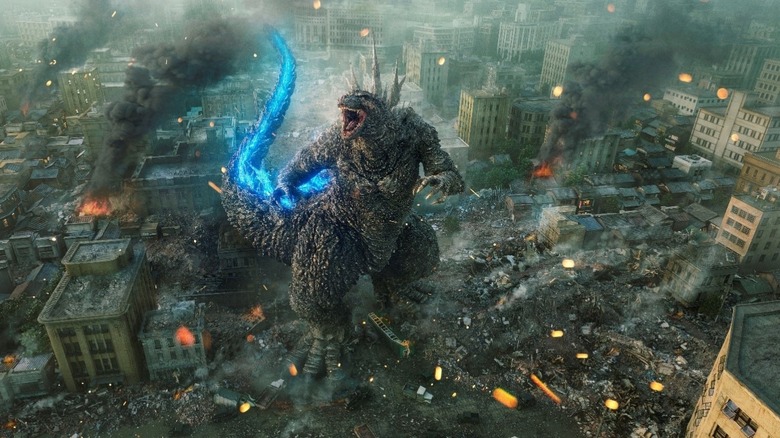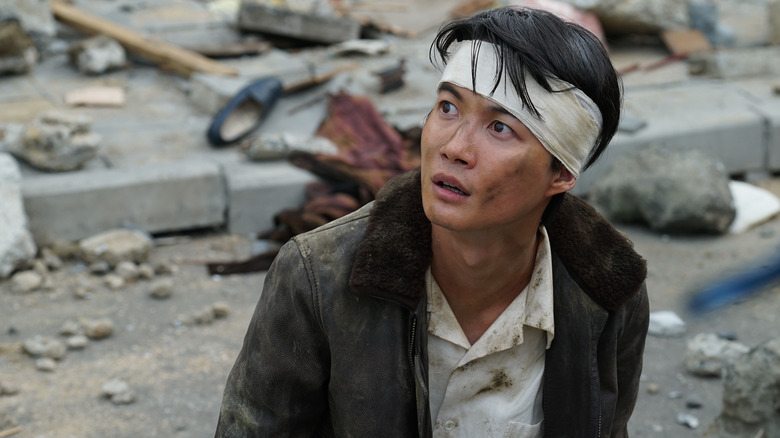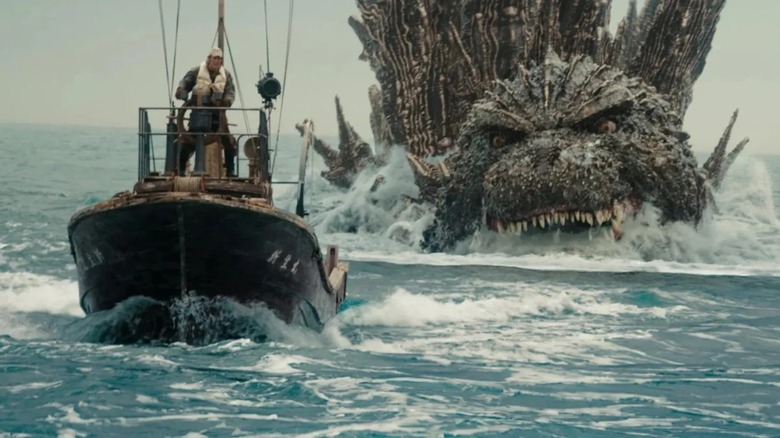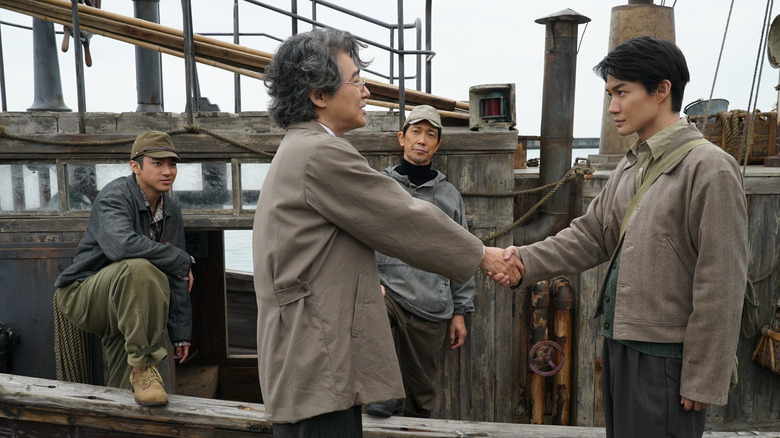Godzilla Minus One Ending Explained: Long Live The King
This article contains major spoilers for "Godzilla Minus One."
First introduced in 1954, Godzilla has become one of the biggest cinematic figures of all time and one of Japan's biggest exports. For nearly 70 years, the character has continued to be reinvented and reimagined. New filmmakers have added their own little spins on the design of the monster, what he represents, and how he impacts the world at large. From an allegory of nuclear destruction to becoming a hero and a defender of the planet. Godzilla has really done it all, including being a destructor of bureaucracy. Now, with "Godzilla Minus One," the king of monsters is returning to his roots as divine punishment.
Indeed, one of Takashi Yamazaki's big achievements as a writer and director is making Godzilla terrifying again. While "Shin Godzilla" explored a monster representing natural disasters — a monster too big for dumb, bureaucratic governments to handle — "Godzilla Minus One" makes him a harbinger of pure death and destruction born from war and nuclear tests. The new film echoes Godzilla's past, with parts of the plot resembling the original 1954 "Godzilla," but also "Godzilla, Mothra and King Ghidorah: Giant Monsters All-Out Attack," while carving a new path for the franchise. Here's how it goes down.
Japan at minus one
"Godzilla Minus One" follows Koichi Shikishima, a former kamikaze pilot who had a brief encounter with Godzilla in the final days of WWII as he faked engine issues to avoid dying in combat. As he returns home after the war he finds a destroyed Tokyo and a population desperately trying to rebuild their lives from the flaming wreckage.
Koichi does this by starting a relationship with a young woman and unofficially adopting an orphaned baby girl — even if he is still plagued by survivor's guilt. He also finds work onboard a boat clearing naval mines with a crew of misfits. Of course, everything goes sideways when his ship comes across Godzilla (now evolved thanks to nuclear tests), who then proceeds to make landfall in Tokyo and lay waste to the city and its inhabitants — including Koichi's partner Noriko.
One of Koichi's crewmates, the scientist Kenji, comes up with a plan to kill Godzilla by sinking him to the bottom of the sea so the pressure kills him. If that doesn't work, they will force him back up to the surface by inflating balloons tied to the monster, using decompression to kill him. The Japanese government refuses to help, not wanting to take responsibility for a military action that may raise concerns from the West. So it is up to civilians and naval veterans to bring the fight back to Godzilla to secure the future of the younger generations.
We hear throughout the movie how disillusioned those who fought in the war are in their government for treating them as expendable. That is why it becomes important that the final battle is not one of the combined military forces against Godzilla, but civilians. They will not fight to the death for their own survival, but for future lives.
A desperate plan
In case the decompression plan fails — which of course it does — Koichi has a mechanic repair his damaged plane from the beginning of the movie, which he will fly into Godzilla's mouth and explode it within. This would destroy the monster and fulfill Koichi's mission, bringing him the honor he so desperately craved and believed to have lost.
Though they manage to drag Godzilla to the bottom of the ocean, it doesn't kill him, and the two decommissioned warships aren't enough to pull the monster back up. That's when a fleet of civilian tugboats and fishing boats arrive to haul Godzilla to the surface — saving the day like Bill and Harry arriving at Sophie's party with a fleet of yachts and other small boats in "Mamma Mia! Here We Go Again." Except, that isn't enough to kill Godzilla either, so Koichi flies right into the monster's mouth and blows his head up. It is a tragic sacrifice, or it would have been had it not been for the mechanic installing an ejection button on Koichi's flight — which was lacking in wartime Japanese fighter jets.
Back on land, Koichi heard that Noriko actually survived Godzilla's atomic blast, and the two have a heartfelt reunion. Still, neither is completely free from the trauma they lived through, as we see Noriko is now suffering from radiation poisoning. What's more, right before the credits, we see a chunk of Godzilla's flesh sinking to the bottom of the ocean while slowly regenerating. Long live the king.
Humans just rule
While every "Godzilla" film technically focuses on its human characters rather than just spending 2 hours with a giant lizard destroying buildings, the great ones make you care about those humans even more than the lizard. "Godzilla Minus One" doesn't just go back in time to make the monster's nuclear allegory even clearer (the atomic breath literally takes the shape of a mushroom cloud), but to say something about the human spirit and institutions. The film is very clear in its anti-war message, and how Japan lost the war the moment the government and military decided it was worth it to send young boys to literally blow themselves up for no reason.
It's why the heroes of "Godzilla Minus One" aren't members of an elite military unit or even the military at large. Instead, it is individuals who lived through the horrors of war and now decide to fight not for honor, not for king and country, but for each other. Individuals who see it worth it to die helping each other rather than abandon each other to their own misfortunes. For the first time in years, humans were not just the heroes of a "Godzilla" movie, but the more interesting characters to follow.
As for where the franchise could go next, we don't know yet. Like "Shin Godzilla," this movie is both standalone, but also includes an ending tag that teases the return of Godzilla. Given how much director Yamazaki was inspired by "Godzilla, Mothra and King Ghidorah: Giant Monsters All-Out Attack," perhaps a sequel with the titular Mothra and King Ghidorah might be possible.



